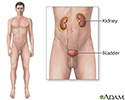Asymptomatic bacteriuria
Screening - asymptomatic bacteria
Most of the time, your urine is sterile. This means there are no bacteria growing. On the other hand, if you have symptoms of a bladder or kidney infection, bacteria will often be present and growing in your urine.
Sometimes, your health care provider may check your urine for bacteria, even when you do not have any symptoms. If enough bacteria are found in your urine, you have asymptomatic bacteriuria.
Causes
Asymptomatic bacteriuria occurs in a small number of healthy people. It affects women more often than men. The reasons for the lack of symptoms are not well understood.
You are more likely to have this problem if you:
- Have a urinary catheter in place
- Are female
- Are pregnant
- Are sexually active (in females)
- Have long-term diabetes and are female
- Are an older adult
- Have recently had a surgical procedure in your urinary tract
Symptoms
There are no symptoms of this problem.
If you have these symptoms, you may have a urinary tract infection, but you do not have asymptomatic bacteriuria.
- Burning during urination
- Increased urgency to urinate
- Increased frequency of urination
Exams and Tests
To diagnose asymptomatic bacteriuria, a urine sample must be sent for a urine culture. Most people with no urinary tract symptoms do not need this test.
You may need a urine culture done as a screening test, even without symptoms, if:
- You are pregnant
- You have a surgery or procedure planned that involves the bladder, prostate, or other parts of the urinary tract
To make the diagnosis of asymptomatic bacteriuria, the culture must show a large growth of bacteria.
- In men, only one culture needs to show growth of bacteria
- In women, two different cultures must show growth of bacteria
Treatment
Most people who have bacteria growing in their urine, but no symptoms, do not need treatment. This is because the bacteria are not causing any harm. In fact, treating most people with this problem may make it harder to treat infections in the future.
However, for some people getting a urinary tract infection is more likely or may cause more severe problems. As a result, treatment with antibiotics may be needed if:
- You are pregnant.
- You recently had a kidney transplant.
- You are scheduled for surgery involving the prostate gland or the bladder.
- You have kidney stones that have caused an infection.
- Your young child has reflux (backward movement of urine from the bladder into ureters or kidneys).
Without symptoms being present, even people who are older adults, have diabetes, or have a catheter in place do not need treatment.
Possible Complications
If it is not treated, you may have a kidney infection if you are at high risk.
When to Contact a Medical Professional
Contact your provider if you have:
- Difficulty emptying your bladder
- Fever
- Flank or back pain
- Pain with urination
You will need to be checked for a bladder or kidney infection.
References
Cooper KL, Badalato GM, Rutman MP. Infections of the urinary tract. In: Partin AW, Dmochowski RR, Kavoussi LR, Peters CA, eds. Campbell-Walsh-Wein Urology. 12th ed. Philadelphia, PA: Elsevier; 2021:chap 55.
Smaill FM, Vazquez JC. Antibiotics for asymptomatic bacteriuria in pregnancy. Cochrane Database Syst Rev. 2019;11:CD000490. PMID: 31765489 pubmed.ncbi.nlm.nih.gov/31765489/.
Zalmanovici Trestioreanu A, Lador A, Sauerbrun-Cutler M-T, Leibovici L. Antibiotics for asymptomatic bacteriuria. Cochrane Database Syst Rev. 2015;4:CD009534. PMID: 25851268 pubmed.ncbi.nlm.nih.gov/25851268/.
Review Date: 8/15/2022
Reviewed By: Linda J. Vorvick, MD, Clinical Professor, Department of Family Medicine, UW Medicine, School of Medicine, University of Washington, Seattle, WA. Also reviewed by David C. Dugdale, MD, Medical Director, Brenda Conaway, Editorial Director, and the A.D.A.M. Editorial team.






